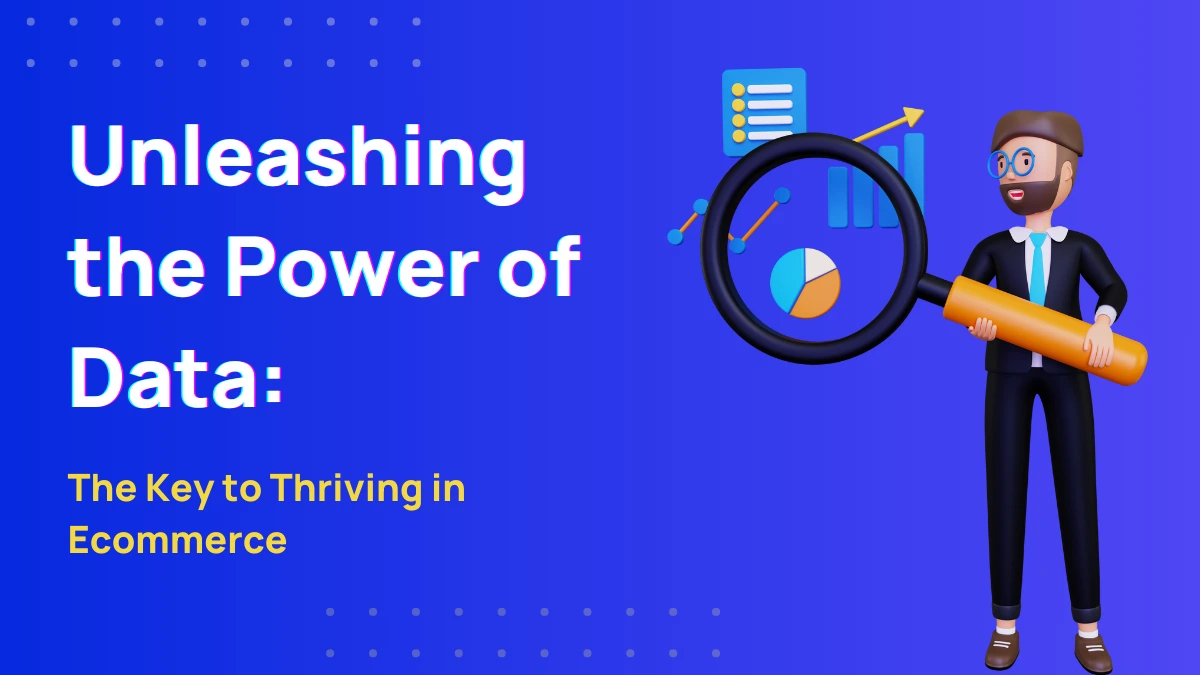“Data is the new fuel,” they say.
Data has become an important part of every aspect of business operations, and ecommerce is no exception.
In this competitive online marketplace, you can gain a significant edge if you have access to and an effective way to utilize data.
The insights gained from data analysis can drive business decisions, inform marketing strategies, and improve overall customer experiences.

Ecommerce has undergone a revolution in the past few years, with advancements in technology and the widespread use of data analytics.
Data-Driven ecommerce strategy adopted by online businesses and leverages big data, machine learning, and other technologies to gain valuable insights into customer behavior and preferences.
And that information you can use to optimize ecommerce operations and drive growth to your Ecommerce business.
In this guide we’ll cover all from customer analytics to website optimization, we will delve into how data is shaping online retail’s future.
Understanding Your Customers

Customer data provides valuable insights into customer behavior, preferences, and trends, allowing companies to make informed decisions and drive growth.
In this part will discuss the importance of understanding your customers through data collection and analysis.
Collecting and Analyzing Customer Data
Data collection is the first step in understanding your customers. You can do this with website analytics integration, customer surveys, and feedback forms.
This data provides valuable insights into customer behavior, such as the most popular products, the average order value, and the customer journey.
Look at the data, and you will find the patterns, that will help make informed decisions, and optimize your business strategy.
Customer Segmentation and Personalization
Customer segmentation divides customers into distinct groups based on common characteristics such as demographics, behaviors, and preferences.
This information allows Ecommerce businesses to create targeted marketing campaigns and improve the customer experience.
Personalization is using customer data to provide a unique and tailored experience for each customer. This can include personalized product recommendations, targeted promotions, and customized communication.
Measuring Customer Loyalty and Satisfaction
Measuring customer loyalty and satisfaction is crucial for ecommerce businesses. This can be done through various methods such as customer surveys, Net Promoter Score (NPS), and customer lifetime value (CLV).
When you measure customer loyalty and satisfaction, you will identify areas for improvement, retain customers, and increase customer lifetime value.
Using customer segmentation and personalization for your Ecommerce business can help you improve the customer experience and drive growth.
Measuring customer loyalty and satisfaction is essential to understanding your customers and will help you retain customers and increase customer lifetime value.
Optimizing Website Performance

Website is often the first point of interaction between any Ecommerce business and its customers.
This makes website performance crucial for ecommerce success. Brands can optimize their websites by collecting data and making data-driven decisions to create a better user experience, increase conversion rates, and drive sales.
In this part, we will explore the key elements of optimizing website performance in the ecommerce space.
Website Analytics and Metrics
Collect the website’s analytics and metrics, and interpret that data of your website.
Take a look at traffic and user behavior. Use the data to understand how customers interact with your website, which pages they visit, and how long they spend on them.
Ecommerce Businesses can make data-driven decisions to improve website performance and user experience by analyzing website analytics.
Standard website analytics and metrics include page views, bounce rate, time on site, and conversion rate.
Page views refer to the number of pages viewed on a website.
Bounce rate is the percentage of visitors who leave a website after visiting only one page.
Time on site refers to the average time a visitor spends on a website.
Conversion rate is the percentage of people who makes a purchase or fills out a form out of all who visited the website.
A/B Testing and Experimentation
A/B testing is experimenting with different website versions to determine which version performs better.
This is done by creating two or more variations of a website and randomly assigning visitors to view one of the variations.
When you compare the two results and see which version is the most effective. And go for that version.
A/B testing can be used to test changes to website elements such as page layouts, button text, and images.
It is an effective way to optimize website performance and increase conversion rates.
Improving Website Speed and User Experience
Website speed and user experience are crucial elements of website performance.
Visitors are likely to stay on a website if it takes less time to load, and a poor loading time leads to poor user experience and can lead to a high bounce rate and low conversion rate.
Website speed can be improved by optimizing images, using a content delivery network, and minimizing third-party plugins.
User experience can be enhanced by making the website easy to navigate, providing clear and concise information, and ensuring the website is mobile-friendly.
In conclusion, optimizing website performance is crucial for ecommerce success. Businesses can make data-driven decisions to improve website speed, and user experience and increase conversion rates by collecting and analyzing website data.
A/B testing and experimentation are powerful tools that can help businesses optimize website performance and drive sales.
Maximizing Marketing Efforts
As an ecommerce business, you’re always looking for ways to reach new customers and drive sales. But with so many different marketing channels and strategies to choose from, it can be tough to know where to focus your efforts. That’s why data plays a critical role in maximizing your marketing efforts. By using data to understand your customers and measure the success of your campaigns, you can make informed decisions and allocate your resources more effectively.
Understanding the Customer Journey
The customer journey refers to the steps a customer goes through when considering, purchasing, and post-purchasing a product or service.
This journey can be broken down into several stages: awareness, consideration, purchase, and loyalty.
To effectively reach and convert customers, you need to understand where they are in their journey and what motivates them at each stage.
One way to gain insights into the customer journey is to use customer data, such as website analytics and customer surveys.
You can identify patterns and develop a better understanding of their needs and motivations by tracking how customers interact with your website and what they’re looking for.
Measuring the Effectiveness of Marketing Campaigns
Once you have a better understanding of your customers and their journey, you can start measuring the effectiveness of your marketing campaigns.
It will help you determine which channels and strategies drive the most traffic and conversions and where to focus your resources.
One way to measure the success of your marketing efforts is by using marketing analytics tools. You can use Google Analytics.
These tools track the results of your campaigns, including conversions, traffic, and revenue, so you can see which campaigns are working and which need improvement.
You can also use A/B testing to experiment with different marketing strategies and see which ones perform the best.
Utilizing Data to Improve ROI
Combine customer data with the campaign’s results, to make data-driven decisions that will help you maximize your return on investment (ROI).
For example, you can use data to optimize your website for better conversion rates, target your marketing efforts more effectively, and personalize your customer interactions.
In conclusion, understanding your customers and maximizing your marketing efforts are critical components of data-driven ecommerce.
Using data to inform your decisions and measure the results of your campaigns, you can optimize your marketing strategies and drive growth for your business.
Improving Inventory Management

In ecommerce, inventory management is a crucial component that determines the success of your business.
It’s easier to make decisions when you have data, and with tools it has become easier to optimize your inventory and ensure that you’re always well-stocked with the right products at the right time.
This part will help you how to use data to improve your inventory management and make the most of your stock.
Inventory Optimization Using Data
Inventory optimization is managing your stock levels to ensure that you have enough to meet customer demand without overstocking or running out of stock.
Data can play a significant role in helping you optimize your list. By collecting and analyzing data on customer demand, sales, and purchasing patterns, you can make informed decisions about how much inventory you need to keep on hand and when to reorder.
One of the ways you can use data to optimize your inventory is by monitoring your stock levels and reordering products based on demand.
For example, if you have a high-selling product, for that you need to stock up on that product more. On the other hand, if you have a product that doesn’t sell that well, you can reduce your inventory stock to minimize waste.
Forecasting Demand and Managing Stock Levels
Forecasting demand is an essential aspect of inventory management. By using data to predict future demand for your products, you can better plan for changes in customer behavior and adjust your inventory accordingly.
It can help you avoid stock shortages and overstock, leading to lost sales or waste.
To forecast demand effectively, you can use historical sales data to identify trends and patterns in customer behavior.
You can also use data to identify the factors that influence the market, such as seasonal trends, marketing campaigns, and changes in the economy.
Minimizing Waste and Maximizing Efficiency
Waste is a significant problem in inventory management, and it can lead to increased costs and lower profits.
To minimize waste, you must ensure that your inventory levels align with customer demand. It means keeping an eye on your stock levels and reordering products as needed to avoid overstocking.
Using data to optimize your inventory management can maximize efficiency and minimize waste. It can help you increase your profits and meet your customers’ needs better.
In conclusion, data-driven inventory management can be a game-changer for ecommerce businesses.
Using data to optimize your inventory, you can make informed decisions about stock levels, forecast demand, and minimize waste. By keeping a close eye on your list and using data to make informed decisions, you can ensure that your ecommerce business runs smoothly and efficiently.
Enhancing the Checkout Experience

One of the critical components of a successful ecommerce store is the checkout experience.
The checkout process is where customers convert into paying customers, and a poor checkout experience can lead to lost sales and a decrease in customer loyalty.
Data-driven ecommerce leverages the power of data to enhance the checkout experience and improve conversion rates.
Analyzing and Improving Conversion Rates
The first step in enhancing the checkout experience is understanding and analyzing your conversion rates.
The conversion rate is the number of customers who complete a purchase divided by the number of visitors to your site. By tracking and analyzing your conversion rate, you can identify areas of your checkout process that may be causing friction and contributing to lost sales.
Once you have identified areas for improvement, you can use data to make informed decisions about enhancing the checkout experience.
This can include A/B testing different elements of the checkout process, such as the placement of buttons or cutting down unnecessary steps, to see what resonates best with your customers.
Personalizing the Checkout Experience
Another way to use data to enhance the checkout experience is by personalizing the experience for each customer.
Personalization can be achieved by using customer data to recommend products, offer tailored discounts, or present payment options that are most likely to result in a successful conversion.
Personalizing the checkout experience improves the chances of a sale and makes the customer feel valued and appreciated.
Streamlining the Checkout Process
Finally, streamlining the checkout process can significantly enhance the checkout experience and improve conversion rates.
Reduce the number of steps involved in the checkout process, to make it easier and faster for customers to complete the purchase.
It can be achieved by removing unnecessary fields, offering guest checkout options, and using intelligent forms that automatically fill in information based on the customer’s previous purchases.
In conclusion, the checkout experience is a crucial component of a successful ecommerce business, and data-driven ecommerce provides the tools and insights necessary to enhance the checkout experience and improve conversion rates.
E-commerce businesses can increase sales and customer loyalty by analyzing and improving conversion rates, personalizing the checkout experience, and streamlining the process, ecommerce businesses can increase sales and customer loyalty.
Utilizing Predictive Analytics
Predictive analytics is a powerful tool that can help ecommerce businesses make data-driven decisions and gain a competitive advantage.
Predictive analytics uses historical data, machine learning algorithms, and statistical models to identify patterns, predict future outcomes, and make informed recommendations.
In this part, we’ll dive into the world of predictive analytics and explore its applications in ecommerce.
Predictive Modeling and Forecasting
Predictive modeling is the process of using historical data to build a statistical model that can make predictions about future events.
This model is used to make informed decisions based on patterns and relationships in the data.
Predictive modeling can be used to forecast a variety of outcomes, including sales, customer behaviour, and market trends.
Predictive Analytics in Ecommerce
Predictive analytics can be used in several ways to drive ecommerce growth. Some typical applications include:
Customer segmentation and personalization: Predictive analytics can segment customers based on their behaviour and preferences, allowing businesses to personalize the customer experience and improve conversion rates.
Inventory optimization: By using predictive analytics to forecast demand and manage stock levels, ecommerce businesses can minimize waste and maximize efficiency.
Marketing: Predictive analytics can help businesses understand the customer journey and measure the effectiveness of marketing campaigns, allowing them to improve ROI and reach their target audience more effectively.
Checkout optimization: Predictive analytics can analyze conversion rates and streamline the checkout process, improving the overall customer experience and boosting sales.
Real-World Applications of Predictive Analytics
Ecommerce businesses of all sizes and industries have widely adopted predictive analytics.
Here are a few real-world examples of how companies have leveraged predictive analytics to drive growth:
For more Practical Examples of Data-driven ecommerce Read Here
In conclusion, predictive analytics is a powerful tool that can help ecommerce businesses make data-driven decisions and drive growth. By leveraging historical data, machine learning algorithms, and statistical models.
Ecommerce businesses can gain valuable insights into customer behavior, optimize their operations, and improve the customer experience.
To stay ahead of the competition, it’s essential for ecommerce businesses to keep up-to-date with the latest trends and technologies in predictive analytics and to experiment and refine their approach continuously.
Discover the path to e-com success: Explore our comprehensive ecommerce guides.
